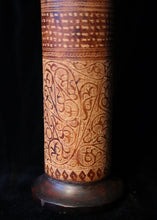
This is a shaman's calendar inscribed on a bamboo with a wooden singa stopper. The engraving on the bamboo is of the finest detail. The stopper is beautifully carved and has a patina.
The Batak Calendar is a lunisolar calendar consisting of 12 months divided to 30 days with an occasional leap month and is derived from the Hindu calendar and is called poralaan. The Batak people do not use it as a means to tell time, but rather for the Batak shaman or Datu to determine auspicious days for planting, performing ceremonies etc.
The Batak carved elaborate wooden stoppers to seal the mouths of the vessels. Many stoppers, such as this example, depict human figures riding horse-like creature called "singa." Combining aspects of horses, snakes, lions, and other animals, singa are mythical creatures associated with fertility and supernatural protection.
Prior to the widespread adoption of Christianity in the early twentieth century, magic formed an important element in Batak religious practice. The religious specialists, known as "datu," performed both benign and malevolent magic using a variety of ritual paraphernalia. The most sacred and powerful of the datu's objects was the potion container, or "guri guri." These containers held "puk puk," a powerful substance made from a ritually executed human victim. Puk puk, it was believed, could force the victim's spirit to do the datu's bidding.






